
Optics is the branch of physics that studies the behaviour and properties of light, including its interactions with matter and the construction of instruments that use or detect it. Optics usually describes the behaviour of visible, ultraviolet, and infrared light. Because light is an electromagnetic wave, other forms of electromagnetic radiation such as X-rays, microwaves, and radio waves exhibit similar properties.

A reflecting telescope is a telescope that uses a single or a combination of curved mirrors that reflect light and form an image. The reflecting telescope was invented in the 17th century, by Isaac Newton, as an alternative to the refracting telescope which, at that time, was a design that suffered from severe chromatic aberration. Although reflecting telescopes produce other types of optical aberrations, it is a design that allows for very large diameter objectives. Almost all of the major telescopes used in astronomy research are reflectors. Reflecting telescopes come in many design variations and may employ extra optical elements to improve image quality or place the image in a mechanically advantageous position. Since reflecting telescopes use mirrors, the design is sometimes referred to as a "catoptric" telescope.
Optics is the branch of physics which involves the behavior and properties of light, including its interactions with matter and the construction of instruments that use or detect it. Optics usually describes the behavior of visible, ultraviolet, and infrared light. Because light is an electromagnetic wave, other forms of electromagnetic radiation such as X-rays, microwaves, and radio waves exhibit similar properties.
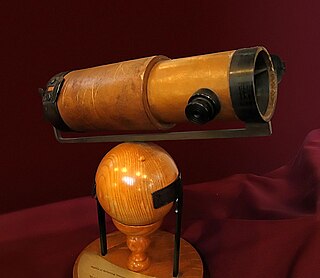
The Newtonian telescope, also called the Newtonian reflector or just the Newtonian, is a type of reflecting telescope invented by the English scientist Sir Isaac Newton (1642–1727), using a concave primary mirror and a flat diagonal secondary mirror. Newton's first reflecting telescope was completed in 1668 and is the earliest known functional reflecting telescope. The Newtonian telescope's simple design has made it very popular with amateur telescope makers.
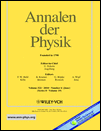
Annalen der Physik is one of the oldest scientific journals on physics and has been published since 1799. The journal publishes original, peer-reviewed papers in the areas of experimental, theoretical, applied, and mathematical physics and related areas. The current editor-in-chief is Stefan Hildebrandt. Prior to 2008, its ISO 4 abbreviation was Ann. Phys. (Leipzig), and after 2008 Ann. Phys. (Berl.).
Dioptrics is the study of the refraction of light, especially by lenses. Telescopes that create their image with an objective that is a convex lens (refractors) are said to be "dioptric" telescopes.

A catadioptric optical system is one where refraction and reflection are combined in an optical system, usually via lenses (dioptrics) and curved mirrors (catoptrics). Catadioptric combinations are used in focusing systems such as searchlights, headlamps, early lighthouse focusing systems, optical telescopes, microscopes, and telephoto lenses. Other optical systems that use lenses and mirrors are also referred to as "catadioptric", such as surveillance catadioptric sensors.
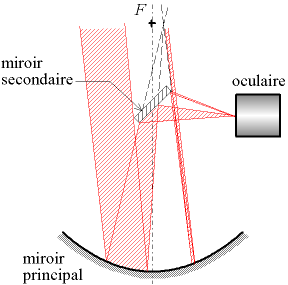
Catoptrics deals with the phenomena of reflected light and image-forming optical systems using mirrors. A catoptric system is also called a catopter (catoptre).
X-ray optics is the branch of optics that manipulates X-rays instead of visible light. It deals with focusing and other ways of manipulating the X-ray beams for research techniques such as X-ray crystallography, X-ray fluorescence, small-angle X-ray scattering, X-ray microscopy, X-ray phase-contrast imaging, X-ray astronomy etc.

A telescope is an optical instrument using lenses, curved mirrors, or a combination of both to observe distant objects, or various devices used to observe distant objects by their emission, absorption, or reflection of electromagnetic radiation. The first known practical telescopes were refracting telescopes invented in the Netherlands at the beginning of the 17th century, by using glass lenses. They were used for both terrestrial applications and astronomy.

The Kaufmann–Bucherer–Neumann experiments measured the dependence of the inertial mass of an object on its velocity. The historical importance of this series of experiments performed by various physicists between 1901 and 1915 is due to the results being used to test the predictions of special relativity. The developing precision and data analysis of these experiments and the resulting influence on theoretical physics during those years is still a topic of active historical discussion, since the early experimental results at first contradicted Einstein's then newly published theory, but later versions of this experiment confirmed it. For modern experiments of that kind, see Tests of relativistic energy and momentum, for general information see Tests of special relativity.
Hans Wolter was a German physicist who designed an aplanatic system of grazing incidence mirrors that satisfied the Abbe sine condition . Wolter showed such a system could be produced using a combination of a paraboloid with either a hyperboloid or ellipsoid secondary. The three simplest designs are outlined and are known as Wolter telescopes of types I, II and III.

A Wolter telescope is a telescope for X-rays that only uses grazing incidence optics – mirrors that reflect X-rays at very shallow angles.
Jakob Johann Laub was a physicist from Austria-Hungary, who is best known for his work with Albert Einstein in the early period of special relativity.
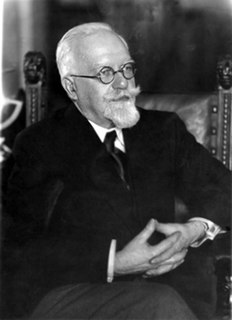
Vladimir Sergeyevitch Ignatowski, or Waldemar Sergius von Ignatowsky and similar names in other publications, was a Russian physicist.
In physics, a quantum is the minimum amount of any physical entity involved in an interaction. The fundamental notion that a physical property can be "quantized" is referred to as "the hypothesis of quantization". This means that the magnitude of the physical property can take on only discrete values consisting of integer multiples of one quantum.
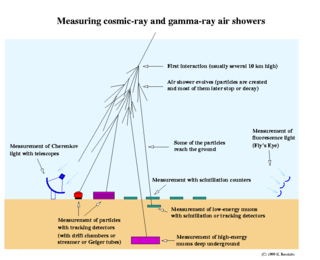
A cosmic-ray observatory is a scientific installation built to detect high-energy-particles coming from space called cosmic rays. This typically includes photons, electrons, protons, and some heavier nuclei, as well as antimatter particles. About 90% of cosmic rays are protons, 9% are alpha particles, and the remaining ~1% are other particles.

Otto Heinrich Wiener was a German physicist.

The history of spectroscopy began in the 17th century. New designs in optics, specifically prisms, enabled systematic observations of the solar spectrum. Isaac Newton first applied the word spectrum to describe the rainbow of colors that combine to form white light. During the early 1800s, Joseph von Fraunhofer conducted experiments with dispersive spectrometers that enabled spectroscopy to become a more precise and quantitative scientific technique. Since then, spectroscopy has played and continues to play a significant role in chemistry, physics and astronomy. Fraunhofer observed and measured dark lines in the Sun's spectrum, which now bear his name although several of them were observed earlier by Wollaston.












